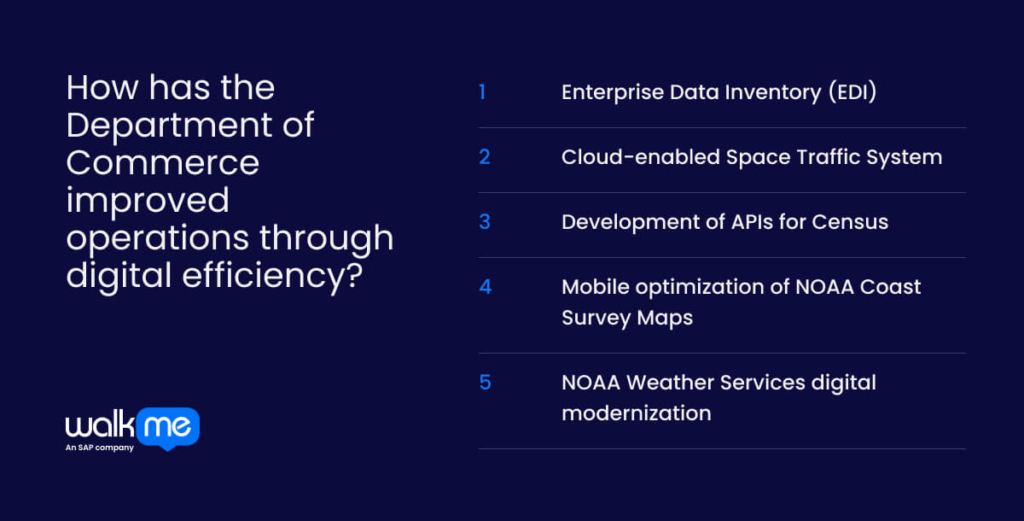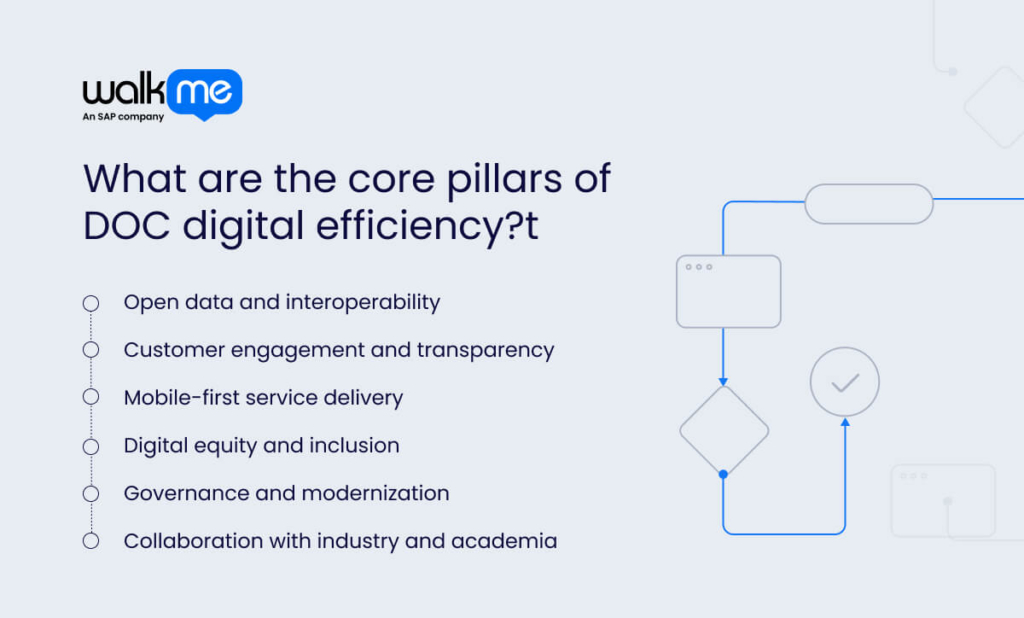Under its umbrella, the Department of Commerce (DOC) manages the U.S. Census Bureau, NOAA, and the Patent and Trademark Office. These agencies play a central role in economic forecasting, disaster response, and innovation.
Its Enterprise Data Governance Action Plan standardizes data use across bureaus, reducing reporting delays and duplication. These digital efficiency measures shape how policymakers respond to inflation, how businesses access IP protections, and how supply chains are modeled.
In a system where accuracy drives outcomes, the DOC’s digital overhaul recalibrates the machinery of government in the national economy.
This article explores how the DOC is using digital tools, data systems, and inclusive strategies to modernize operations and drive economic performance.
What is the digital efficiency of the Department of Commerce?
Digital efficiency in the Department of Commerce means using smarter digital tools to save time, reduce waste, and improve services.
One standout example is the National Technical Information Service’s partnership with agencies to apply machine learning in fraud detection, which has sped up investigations that once took weeks.
It’s also about upgrading legacy systems so data flows between departments without bottlenecks. Instead of staff chasing spreadsheets, insights now arrive in real time.
These changes enable the DOC to concentrate on promoting trade, digital innovation, and job creation. Digital efficiency is now seen as structural, strategic, and increasingly mission-critical, which we will cover in the next section.
Why is digital efficiency important in the Department of Commerce?
Streamlining digital operations within the Department of Commerce is crucial for achieving economic agility.
Faster decisions enable entrepreneurs to secure protections quickly, thereby strengthening market confidence and attracting investment.
When systems function without friction, productivity improves across agencies and industries.
Adopting modern architecture is essential to maintaining the United States’ leadership position in research, development, and trade.
Failing to prioritize digital transformation could mean the difference between driving digital resilience and falling behind smarter economies.
How has the Department of Commerce improved operations through digital efficiency?

At this point, you’ll have a clear understanding of what digital efficiency means in the Department of Commerce and why it matters. Grasping these concepts is essential because they directly impact how the government supports business, trade, and economic stability.
Enterprise Data Inventory (EDI)
The DOC’s Enterprise Data Inventory catalogs every dataset managed across its bureaus to create a single source of truth.
Centralized inventories identify what data exists, where it resides, and who is responsible for maintaining it. With inventory in hand, internal teams avoid redundant data collection and overlap.
The Commerce Chief Data Officer has simplified data governance across 60 systems, helping analysts access data nearly 30% faster. This speeds up policy analysis and also supports cross-bureau collaboration.
Cloud-enabled Space Traffic System
The DOC launched the cloud-based Space Traffic Coordination System (TraCSS) under NOAA’s purview. It provides real-time collision warnings for satellites and orbital debris.
Operating in a secure cloud ecosystem, TraCSS scales to track thousands of objects. This digital shift enhances national space safety and demonstrates the ability to deploy agile systems without legacy constraints.
Development of APIs for Census
The Census Bureau is continuing to expand its Data API. Developers can now request datasets directly using RESTful calls. New “API” buttons on economic indicator tables make it easier for third-party tools to access data.
Ongoing improvements make Census data easier to use with modern software. This reduces manual downloads and enables real-time trend analysis for more informed business and policy decisions.
Mobile optimization of NOAA Coast Survey Maps
NOAA’s Office of Coast Survey sunset 1,007 traditional paper charts to focus on digital ENC maps.
Their Custom Chart tool enabled the creation of mobile and PDF charts, improving usability on phones and tablets. This pivot dramatically increased real‑time download activity and strengthened navigational readiness for commercial and recreational mariners.
NOAA Weather Services digital modernization
That added computational horsepower enhances AI-driven forecasts, improving the accuracy of severe-weather predictions. Faster projection cycles also translate into earlier warnings for coastal communities and businesses.
What are the core pillars of DOC digital efficiency?

After understanding how operations at the DOC are enhanced through digital efficiency, the next step is to examine its core pillars.
Doing so will help you visualize how strategy translates into measurable outcomes and how these foundations support long-term agility.
Open data and interoperability
Open data means that anyone, including researchers, businesses, or the public, can access it easily. Interoperability ensures that systems across different bureaus can talk to each other. Together, they help the DOC avoid duplication and allow smarter use of public information. It also means faster decisions, better tools, and fewer barriers to innovation across government and industry.
Customer engagement and transparency
The DOC designs its ministrations around user needs, not agency silos. It now shares performance data, digital service updates, and key decisions with the public in real-time. This builds trust, invites feedback, and strengthens customer engagement. Transparency in this regard shows people how and why choices are made and how those choices affect them.
Mobile-first service delivery
Modern services must work on the devices people actually use, like phones and tablets. The DOC now prioritizes mobile access as a fundamental need from the outset. Whether it’s checking business stats or downloading weather alerts, tools are being redesigned to be fast, clear, and reliable on smaller screens.
Digital equity and inclusion
Digital access should work for everyone, not just those with the fastest internet or the latest devices. The DOC is removing digital access barriers by designing tools that are usable by people with different abilities, languages, and technology levels. Equity means making sure no one is left behind, and inclusion ensures that voices from every background help shape those services.
Governance and modernization
Contemporary tools only work if they’re built with clear directions and have updated systems. Governance provides structure, defining how data is managed, who is responsible, and how changes are tracked. Modernization upgrades the technology itself. Together, they reduce risk and ensure digital improvements don’t fall apart over time.
Collaboration with industry and academia
Working with tech leaders, startups, and universities, the DOC aims to bring in new ideas, talent, and research. These partnerships help test emerging technologies faster and bring real-world expertise into government projects. Tapping into outside knowledge means avoiding outdated thinking and building smarter systems that serve the public.
How does the Department of Commerce’s digital economy agenda drive operational and economic gains?
Now that the core pillars of digital efficiency in the DOC have been discussed and understood, the next step is to explore how its digital economy agenda drives both operational and economic gains.
Understanding this will enable you to connect internal digital improvements with broader outcomes and see how strategy translates into real-world growth.
Promoting an open internet
Keeping the internet open and unrestricted means everyone can use it equitably. The DOC works to prevent obstructions, so businesses, both big and small, can connect and grow. When the internet is open, ideas travel easily, enabling the U.S. economy to have better chances of success.
Supporting innovation and access for businesses
The DOC helps small and medium-sized businesses access technology and funding. This support reduces costs, enabling enterprises to create and sell new products more quickly. As more companies expand, they create jobs and contribute to the U.S. staying competitive in a rapidly changing world where technology is evolving fast.
Leveraging digital trade and eCommerce data
Collecting data on online buying and selling helps the DOC understand what customers want and how markets change. This information guides smarter regulations and business management. When companies utilize this data, they operate more effectively and contribute to the success of the expanding digital marketplace.
How does the Department of Commerce build trust and transparency through digital services?
Trust and transparency are among the essential foundations for successful digital services. Understanding how the DOC develops these qualities helps you see why reliable and clear communication is essential.
Promote transparency with data.gov
Data.gov makes government data openly accessible to everyone. The DOC uses it to share economic, environmental, and business information transparently. This openness allows citizens, researchers, and companies to verify facts, build tools, and make informed decisions. It helps strengthen trust in government through clear, public data access.
Use tools and councils for feedback
The DOC actively listens by using online platforms and advisory councils. These channels gather public and expert input on digital services and data use. Feedback helps identify issues and improve systems, ensuring services meet real needs. This two-way communication builds trust and makes the government more responsive.
Publish APIs and data inventories
Offering APIs and detailed data inventories lets developers and agencies access new information quickly. The DOC provides these tools to enable partners to integrate government data into apps and workflows with precision and accuracy. This approach speeds innovation and boosts efficiency by making data easy to find and use across platforms.
What future trends will shape Commerce’s digital efficiency?
Digital efficiency at the Department of Commerce drives faster decision-making, better public services, and stronger economic growth.
You’ve seen how open data, smart technology, and clear communication form the foundation of this progress.
Continued investment is crucial, as technology and public needs evolve. The future will bring more AI digital transformations and collaboration across agencies and industries.
As the DOC adapts, it will shape how the government and businesses innovate and compete globally.
Understanding this is key to recognizing where digital progress meets real-world impact on policy, business, and the economy itself.
FAQs
The DOC runs numerous programs, making it challenging to update all its systems. Some tools are outdated, and not all staff members possess the same digital skills. Budget limits and data safety also make things tricky. To expand digital services, the DOC needs strong planning, innovative tools, and more training for its teams.
Data is observed to understand what’s working and what’s not. This helps resolve problems more quickly and enables better decision-making. It also means different teams can share information and work together. Using data allows the DOC to reduce costs and deliver better services to the public.
The Digital Equity Act helps more people get online by funding internet access, devices, and training. As more people use digital services, the DOC can serve them more effectively. It also helps make sure no one is left out, making digital tools more useful, fair, and effective.

